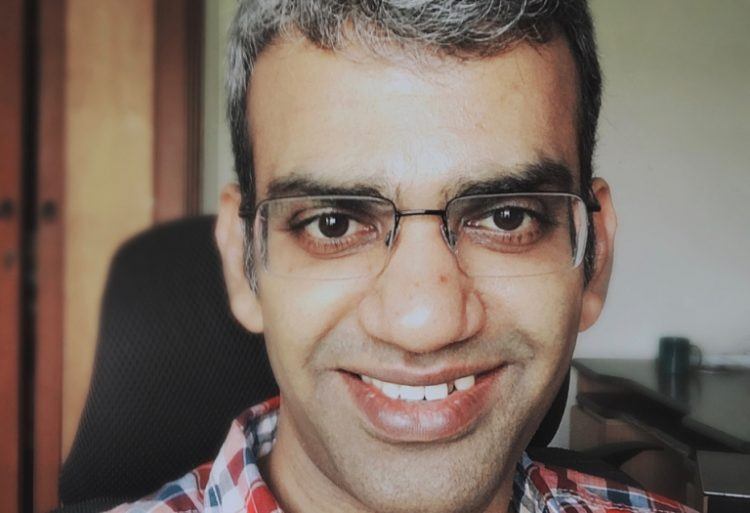Clik here to view.

Co-founder Jeyashankher Ramamirtham with three different face filters. Photo credit: MaskUp.
Look at the first of the three pictures carefully. It is not a simple snap taken on Holi, the Indian festival of colors. In fact, the colors are not real at all! They’ve been put on the face using an augmented reality (AR) app – and it’s not Snapchat.
MaskUp, an Indian app, has launched ‘Holi selfie face filters’ to mark the festival being celebrated today.
And by doing so, it has gone where better known apps like Snapchat, Face Swap, and MSQRD have not – that is, brought in a specific Indian context to AR.
The app has been devised by Chennai-based Makesto Infotech run by ex-Googlers Jeyashankher Ramamirtham and Pradnya Karbhari. MaskUp was launched on Play Store on January 14 as a very early beta.
“We currently have about 5,000 monthly active users. Holi is our first major experience launch,” says Jeyashankher.
What the Holi app does
All you need to do is switch on the app, click on the box showing colors, and tap on the screen. Out flies a cloud of color and settles on your face! And this happens every time you tap, with a different color erupting on screen each time.
Clik here to view.

Co-founder Pradnya Karbhari dons the face filters here.
Holi marks the onset of spring in India, and true to the spirit of the season, people go wild putting colors on each other – dry powder, water, or even sticky paint that could take days to come off. MaskUp recreates that look, with fairly whacky results.
A green blotch around your nose, red on your right cheek, blue on the left, and yellow around the eyebrows!
“We believe our app gives that Holi look, without the troubles of having to scrub the colors off the face!” says Jeyashankher.
You could then take a selfie or video, save it to your phone gallery, and send it to friends and family without actually having played with real colors. A cheerful “Happy Holi” tag flashes on top of every picture.
“The cultural context of the festival is to celebrate with friends and have fun throwing colors at each other. And finally take pictures and videos of the colorful faces that everyone ends up with. We thought this kind of fun can be captured in an AR format,” Jeyashankher tells Tech in Asia.
Going Indian
The AR & VR market in India is projected to grow at 55 percent annually for the next four years. So this may be a good time to design AR apps with Indian users in mind.
Snapchat, MSQRD, and Face Swap are among the apps that youngsters in India like to use. You can look like Donald Trump one second, and turn into a cheetah the next, or have a rainbow coming out of your mouth!
But who lets you play Holi – well, without really playing Holi?
MaskUp uses computer vision, graphics, and 3D modeling algorithms, as do other AR apps. “But we have developed our own technology solutions for face filters,” says Jeyashankher.
Clik here to view.

Co-founder Jeyashankher Ramamirthan (without the face filters).
The first technology is called 3D expressions. The second is 3D face painting, which is used for the Holi experience.
I had a bit of trouble exiting the app and it made my phone heat up, but I must confess I couldn’t resist clicking a dozen Holi selfies with it anyway!
MaskUp’s charm lies in some typically Indian options. For instance, you could put on a long, twirly moustache with a huge, colorful turban.
“Other than Holi, our most popular Indian filters include the Turban, and the Raees face mask.” In case you are wondering, Raees is the latest Indian movie starring Bollywood superstar Shahrukh Khan.
In a tribute to another superstar, Rajnikanth, they have the ‘glasses animation’ filter. “He has a really cool style of wearing glasses in some of his movies, and we have tried to imitate that,” says Jeyashankher.
The ‘deer in a forest’ filter captures the beauty of the lush green campus of the Indian Institute of Technology-Madras, Jeyashankher’s alma mater. Coming up is a filter for Pongal, a festival celebrated in southern India.
“Being present in the region allows us to engage and develop deeply cultural augmented reality experiences,” says Jeyashankher. “Every festival, movie, and sporting event presents an opportunity for us.”
This post Holi selfie: 2 ex-Googlers bring AR to India’s festival of colors with a localized Snapchat appeared first on Tech in Asia.